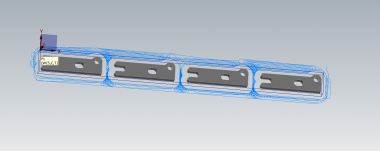Finegrain
Diamond
- Joined
- Sep 6, 2007
- Location
- Seattle, Washington
Hello,
I'm quoting a large quantity, small (1/2" x 1-1/2" x 1/4" thick) part in 303 stainless. I use HSM/trochoidal/Dynamic Mill on almost everything else, and that strategy looks like this, for 4 parts:

I'm thinking maybe of going another way on this part, like a segmented rougher:
Maritool 1/4" TiAlN rougher
I'd expect to go slower, but with higher engagement. Machine is 30-taper, 16k max RPM.
Anybody doing similar work, and can advise?
Thanks, and regards.
Mike
I'm quoting a large quantity, small (1/2" x 1-1/2" x 1/4" thick) part in 303 stainless. I use HSM/trochoidal/Dynamic Mill on almost everything else, and that strategy looks like this, for 4 parts:

I'm thinking maybe of going another way on this part, like a segmented rougher:
Maritool 1/4" TiAlN rougher
I'd expect to go slower, but with higher engagement. Machine is 30-taper, 16k max RPM.
Anybody doing similar work, and can advise?
Thanks, and regards.
Mike
Last edited:

